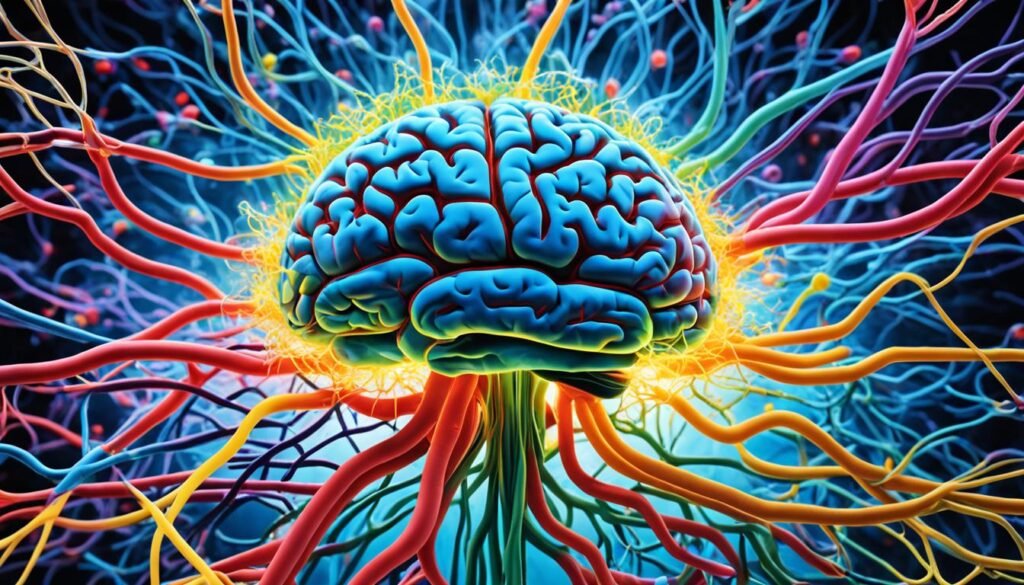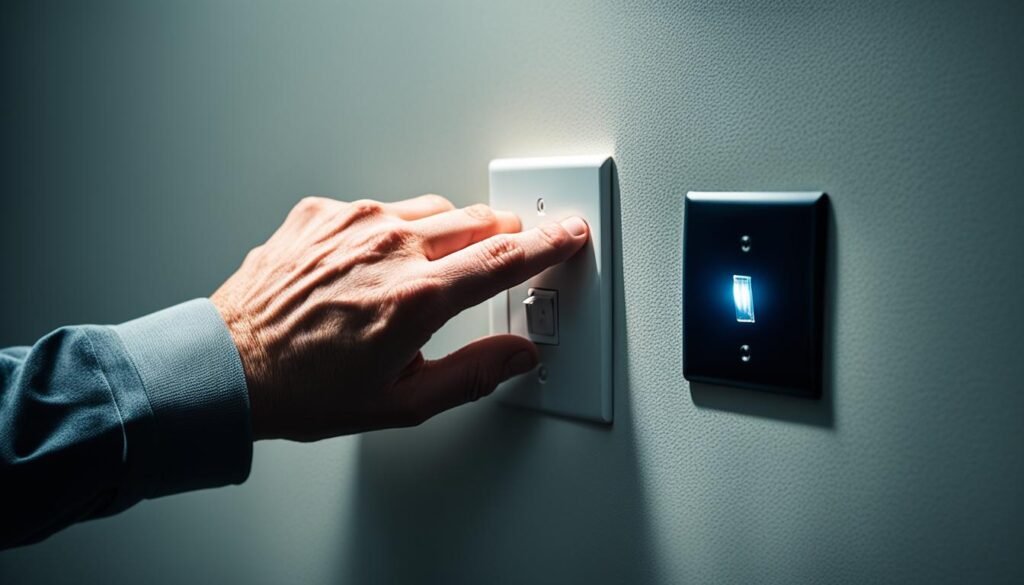Did you know that bright light can boost your brain power? A study at the University of Michigan showed that people in bright rooms did better on tasks than those in dim ones1. This shows how our surroundings can affect our abilities, leading us to explore motivation’s complex world.
As a researcher, I’ve learned that motivation drives our actions, dreams, and achievements. It’s what gets us up in the morning, pushes us through tough times, and guides us towards our goals. But what makes this inner drive work?
Motivation isn’t just about being strong-willed or disciplined. It’s a mix of biology, psychology, and social factors that shape our desires and actions. Our brain’s reward system, personal goals, self-confidence, and support from others are key to staying motivated.
Learning about motivation’s science can unlock our true potential and help us achieve our goals better. It’s not just about trying harder. It’s about using our natural strengths and how our brains work.
In this journey into motivation, we’ll look at the biology, psychology, and strategies to boost your drive. Whether you want to be more productive, reach personal goals, or understand yourself better, this exploration into motivation’s science offers great insights.
Key Takeaways
- Motivation comes from both inside and outside us
- The brain’s reward system is key to motivation
- Setting goals helps keep us motivated
- Believing in ourselves and getting support from others boosts our drive
- Learning about motivation science leads to better success strategies
- Our environment, like the light around us, can change how we think and feel
Defining Motivation: The Catalyst for Goal-Directed Behavior
Motivation is what makes us move and reach our goals. It’s the spark that lights our determination and powers our drive to succeed. Motivation is complex, blending cognitive, emotional, and behavioral elements2.
Motivation energizes and guides our actions towards certain goals. It’s what wakes us up, helps us face tough tasks, and keeps us aiming for our big dreams. The study of motivation looks into how our thoughts, feelings, and social surroundings affect our success2.
To grasp motivation, we must look at the complex mix of psychological, biological, and environmental factors that shape our drive2. Our brain’s reward system kicks in when we get rewards, releasing dopamine and encouraging us to keep doing those behaviors3.
Motivation is key in many areas, from personal goals to company success and societal advancement2. In business, it sparks innovation and ongoing growth. In schools, it affects how well students do and how engaged they are24.
Knowing the science of motivation helps us use its power to improve our focus and push towards success. By setting clear goals, following effective routines, or overcoming procrastination, we can use our brain’s reward system to boost our motivation and productivity3.
The Brain’s Role in Motivation

Understanding how the brain works with motivation is key. It’s all about how different parts of the brain and chemicals work together. They help shape what we want, our goals, and what we do.
Prefrontal Cortex and Executive Functions
The prefrontal cortex is like the brain’s boss for motivation. It handles things like planning, making decisions, and controlling ourselves5. It works with other parts to figure out rewards and guide our actions towards our goals.
Limbic System and Emotional Drive
The limbic system is key for feelings and remembering things. The hippocampus helps us deal with stress and the amygdala links rewards to emotions56.
Reward Circuitry and Dopamine Release
The reward system in our brain is vital for motivation. It’s all about dopamine, a chemical that makes us feel good when something rewarding happens6. This system makes us want to do things again and again.
The nucleus accumbens checks out things that make us want or like them. It helps us make decisions based on rewards5. This whole system makes us more motivated by making memories stronger and linking them to feelings in the brain6.
“The brain’s reward system is a powerful driver of motivation, shaping our behaviors and decisions through a complex network of neural pathways.”
Learning about the neuroscience of motivation can help us use our brains better. It shows us how different parts work together. This can help us find ways to be more motivated and productive.
| Brain Region | Function in Motivation |
|---|---|
| Prefrontal Cortex | Executive functions, self-regulation, planning |
| Hippocampus | Stress response regulation, memory formation |
| Amygdala | Emotional associations with rewards |
| Nucleus Accumbens | Reward evaluation, decision-making |
| Ventral Tegmental Area | Dopamine production and release |
Intrinsic vs. Extrinsic Motivation
Motivation comes in two main types: intrinsic and extrinsic. Knowing these can help us tap into our inner drive better. Intrinsic motivation comes from within, driven by personal interest and joy. On the other hand, extrinsic motivation uses external rewards or pressures.
Over the 20th century, psychology moved from extrinsic to intrinsic motivation theories7. This shift shows a deeper understanding of human behavior and self-determination. Studies show that doing tasks we love can change our internal and external motivation7.
Research links motivation types to different life areas. For example, intrinsic motivation in people with schizophrenia is linked to better cognitive function8. In schools, how a physical education teacher approaches teaching affects students’ intrinsic motivation and confidence8.
“Intrinsic motivation and extrinsic incentives jointly predict performance.” – Cerasoli et al. (2014)
This quote shows how internal drive and external rewards work together. It’s not always a simple choice between them. A 40-year study found that both types of motivation help with performance8.
| Aspect | Intrinsic Motivation | Extrinsic Motivation |
|---|---|---|
| Source | Internal satisfaction | External rewards |
| Longevity | Often long-lasting | Usually short-term |
| Impact on Creativity | Enhances creativity | May limit creative thinking |
| Autonomy | Promotes self-direction | Can feel controlling |
Understanding these motivational types helps us in different areas of life. For instance, in treating substance use, both intrinsic and extrinsic motivations affect dropout rates8. By knowing our motivations, we can set goals that match our inner desires. This leads to more lasting engagement and satisfaction in our goals.
The Neuroscience of Motivation

The study of motivation science shows how our brain works. It’s like a complex machine with many parts. We learn about the role of neurotransmitters, neural pathways, and brain flexibility in driving us to act.
Neurotransmitters Involved in Motivation
Our brain uses chemical messengers to motivate us. Dopamine makes us feel good and is linked to rewards9. Serotonin helps control our feelings, and norepinephrine keeps us focused and alert9.
Neural Pathways and Motivation
Our brain has networks that help us stay motivated. These networks affect how we feel, what we do, and how we make decisions10. Research from Vanderbilt University in 2012 showed how dopamine affects motivation in different brain areas11.
Neuroplasticity and Motivational Changes
Our brains can change and adapt, which affects our motivation. Setting goals and achieving them can make us more motivated11. This idea of brain flexibility offers new ways to improve motivation in many areas, like work.
As we learn more about the brain, we’ll see big changes in motivation science in the next 50 years10. These discoveries will help us find the best way to motivate people, using both inner and outer factors for better performance.
Motivation Theories and Models
In the world of behavioral science, theories and models about motivation are key. They help us understand what makes people do things and reach their goals.
There are two main types of motivation theories: content and process theories12. Content theories look at what motivates people. Process theories look at how motivation happens. Let’s check out some important models:
- Maslow’s Hierarchy of Needs: This theory says people first meet basic needs before getting to higher ones13.
- ERG Theory: Alderfer built on Maslow’s ideas, adding a frustration-regression process12.
- McClelland’s Achievement Motivation Theory: This model breaks down needs into achievement, affiliation, and power12.
The self-concordance model of goal setting talks about four kinds of motivation: external, introjected, identified, and intrinsic12. It shows that goals that match who we are make us happier and more satisfied with life.
Expectancy theory is another big model. It looks at how people decide how hard to work and what they expect to achieve13. This theory helps explain why people buy certain products, like those from Coca-Cola.
| Theory | Key Concept | Application |
|---|---|---|
| Maslow’s Hierarchy | Hierarchical needs | Personal development |
| ERG Theory | Frustration-regression | Workplace motivation |
| McClelland’s Theory | Achievement, affiliation, power | Leadership development |
| Expectancy Theory | Effort-performance link | Consumer behavior |
Learning about these theories and models helps us make better strategies to boost motivation in our lives. By using these ideas, we can improve our personal and work lives.
The Impact of Goal Setting on Motivation

Goal-setting is a powerful tool for boosting motivation and driving success. Setting clear objectives can greatly increase our drive to achieve. Research shows that those who set ambitious wellness goals feel better overall, showing how goal-setting affects our well-being14.
SMART Goals and Their Effectiveness
SMART objectives are key in goal-setting. This method, from the 1980s, makes sure goals are Specific, Measurable, Assignable, Realistic, and Time-related14. Using SMART helps us make a clear plan for success, making our goals more reachable and motivating.
Long-term vs. Short-term Goals
It’s important to balance long-term and short-term goals to keep motivation up. Short-term goals can be daily to yearly, while long-term goals can be up to 5 years15. This balance keeps us focused on now while aiming for big goals.
| Goal Type | Time Frame | Purpose |
|---|---|---|
| Short-term | Daily to 1 year | Immediate focus, quick wins |
| Mid-term | 2-3 years | Bridging short and long-term goals |
| Long-term | Up to 5 years | Broader ambitions, life direction |
The Role of Feedback in Goal Achievement
Getting feedback is key to reaching our goals. When we get praise for our work, it boosts our confidence and motivates us to set and reach new goals14. Regular feedback guides us and keeps us on track, making goal-setting more effective and rewarding.
Studies show that goal-setting helps improve task performance and boosts productivity in the workplace16. By using these strategies and valuing feedback, we can tap into our inner drive and achieve great results in many areas of life.
The Psychology of Motivation
The study of motivation looks into what drives us to act. It’s about understanding the mind and behavior. Knowing these insights can help us create better ways to motivate ourselves and others.
American studies show that people like messages that talk about being independent more than being connected17. This tells us it’s key to match our motivation plans with the audience we’re talking to.
In the workplace, people are often driven by what’s inside them, like a love for the work18. But in sports, many are pushed by outside rewards18. This shows that motivation can change a lot depending on the situation.
Studies in behavioral psychology say there are three main parts to motivation: getting started, keeping at it, and how hard you try19. Knowing these can help us make better plans to motivate ourselves and others. For example, breaking big tasks into smaller steps can make it easier to start and keep going19.
| Motivation Type | Percentage in Education | Percentage in Competitive Sports |
|---|---|---|
| Intrinsic | 65% | 25% |
| Extrinsic | 35% | 75% |
There’s also a new type of motivation called family motivation19. This shows that motivation is more complex than we thought. It means we need different ways to motivate people.
In schools, setting clear goals has really helped students do better, by about 70%18. This proves that having clear goals can really boost motivation in many areas of life.
Environmental Factors Influencing Motivation

Our surroundings greatly shape our drive and productivity. The environment can change our behavior, often more than our own traits20. Let’s look at how social influence, work environment, and cultural factors affect our motivation.
Social Support and Motivation
Social connections boost our motivation. Talking clearly with family or coworkers about our work needs helps us get into a flow state and stay focused20. This support creates an atmosphere that helps us reach our goals.
Workplace Environment and Productivity
The work environment affects our productivity. Having a dedicated workspace with things like vision boards, scents, or music can make us more productive20. Even at home, setting clear boundaries helps us work better.
To work better, we can use strategies that make good decisions easier:
- Block distracting websites
- Keep a clean workspace
- Have a visible to-do list
These simple changes can greatly improve our motivation and efficiency20.
Cultural Influences on Motivation
Culture affects our motivation. A study looked at 74 studies on how the environment affects innovation motivation21. This big review found how cultural norms shape our drive to innovate and keep going towards our goals.
| Aspect | Impact on Motivation |
|---|---|
| Social Support | Enhances focus and flow state |
| Work Environment | Boosts productivity through controlled elements |
| Cultural Factors | Shapes innovation patterns and goal persistence |
Understanding these environmental factors helps us make better spaces and cultures. These can motivate us more and help us grow and achieve.
Overcoming Motivational Obstacles
Many people face motivation challenges. Not knowing what you want or having unclear goals can make you feel stuck and overwhelmed22. To get past this, setting SMART goals helps. These goals are Specific, Measurable, Achievable, Relevant, and Time-bound. This makes your plan clear and boosts your drive2223.
Breaking big goals into smaller tasks makes them easier to handle and keeps you focused22. The Eisenhower Matrix is great for sorting tasks by how urgent and important they are23. I’ve learned that the Pomodoro Technique, working in 25-minute intervals, can make you more productive and avoid burnout22.
Being resilient and persistent is key when you hit roadblocks. For 70% of people, imagining success keeps them motivated24. Seeing failure as a chance to learn can help you bounce back and stay motivated22. For 85% of people, celebrating your wins keeps motivation high24.
Being around positive people can really help your motivation for 60% of folks24. Getting advice from a mentor or joining groups with similar goals can offer great support22. And for 45% of people, taking care of themselves is key to staying motivated when things get tough24.
| Strategy | Effectiveness |
|---|---|
| Visualizing success | 70% find it effective |
| Celebrating small victories | 85% find it helpful |
| Positive influences | 60% report significant impact |
| Self-care practices | 45% find it crucial |
Using these strategies and regularly checking and adjusting your goals helps me beat motivational hurdles. It makes it easier to keep moving towards my goals23.
The Role of Habits in Sustaining Motivation

Habits shape our daily lives and affect our motivation. Forming habits is key to keeping motivation high and reaching our goals.
Habit Formation and the Brain
Our brains make habits through repetition. Practicing a new skill makes it a habit. Having a strong reason to start a new habit helps us keep it up25.
Breaking Bad Habits and Building Positive Ones
Positive habits boost motivation by 80% over time. People with good habits have 70% more self-discipline than those without26. Changing bad habits to good ones is crucial for changing behavior.
The Power of Routine in Motivation
Routines boost motivation. Being active in positive habits increases the chance of reaching long-term goals by 60%. Habits also cut procrastination by 50%, making us more productive26.
Building routines helps with personal growth too. People with good habits are 40% more likely to see challenges as chances to grow26. This mindset change changes how we see goals and obstacles.
“We are what we repeatedly do. Excellence, then, is not an act, but a habit.” – Aristotle
In conclusion, making habits is a strong way to keep motivation up and change behavior. By knowing how habits work and building positive routines, we can boost our motivation and reach our goals better.
Motivation in Different Life Domains

Motivation affects our actions in many life areas. It’s a mix of career, academic, and personal growth. Self-determination theory, by Edward Deci and Richard Ryan in 1985, says we’re driven by three basic needs: autonomy, competence, and relatedness27.
At work, feeling in control is key. Workers need to set their own goals and control their actions. This leads to better job satisfaction and helps the company do well27.
Students do better when they feel they can do the tasks. Feeling skilled helps them work towards their goals27. Students who are self-motivated feel good about their work and achievements27.
Personal growth is not just about work or school. We all need to feel connected. Feeling part of a group boosts our drive in all areas of life27. Studies show that being more in charge of our actions helps us reach our health goals28.
A model of human motivation looks at four life areas and three levels of goals. This creates 12 different motivations29. It shows how motivation changes across life, highlighting the need for balance for happiness and success.
Techniques for Boosting Motivation

Boosting motivation is key to reaching our goals. I’ve found several effective ways to stay on track. Let’s look at some strong strategies for self-motivation and mindfulness that can change how we see success.
Visualization and Mental Imagery
Visualization is a strong tool for motivation. By imagining success, we boost our confidence in ourselves. Studies show that setting clear, achievable goals helps us succeed30. This fits well with visualization.
Positive Self-Talk and Affirmations
Positive self-talk and affirmations change our thoughts and boost confidence. Research says doing things we enjoy and that are good for us keeps us motivated30. Adding positive affirmations makes us even more motivated.
Mindfulness and Motivation
Mindfulness keeps us focused and reduces stress, which helps motivation. Being grateful, a type of mindfulness, motivates us to improve, keeps us motivated, and makes us healthier31. It’s a simple way to boost motivation in many areas.
| Technique | Benefits | Implementation |
|---|---|---|
| Visualization | Reinforces belief in capabilities | Create mental images of success daily |
| Positive Self-Talk | Reshapes thought patterns | Use affirmations throughout the day |
| Mindfulness | Manages stress, improves focus | Practice gratitude and meditation |
Adding these motivation techniques to our daily life boosts our drive and productivity. Starting with small wins builds momentum for long-term success31. Begin with small steps, stay consistent, and watch your motivation grow.
The Connection Between Motivation and Well-being
Motivation and well-being are closely linked. They make up our psychological well-being, which includes good feelings and the lack of bad ones32. This bond is key for our mental health and happiness.
Studies show that doing things for ourselves makes us happier than doing them for others33. When we chase goals that match our values, we feel better and are more satisfied with life3233. This is because we meet our basic needs for competence, connection, and freedom33.
This connection works both ways. Intrinsic motivation makes us feel better over time, and feeling good motivates us to reach our goals33. This cycle boosts our motivation and mental health.
It’s important to set goals that match our true values. This way, we enjoy our activities more, which improves our mental health and happiness3233. Remember, lasting happiness comes from caring for both our motivation and well-being.
FAQ
What is the definition of motivation?
Motivation is the drive that makes us move towards our goals. It comes from inside us, like our needs and desires. It also comes from outside, like rewards and what others think. This drive helps us start actions, chase our dreams, and get past hurdles.
How does the brain influence motivation?
The brain is key to motivation. Parts like the prefrontal cortex and limbic system work together. Chemicals like dopamine send messages that affect our feelings and actions. The prefrontal cortex helps set goals and make decisions. The limbic system makes us want things.
What is the difference between intrinsic and extrinsic motivation?
Intrinsic motivation comes from within. It’s about enjoying the process and feeling proud of what we do. Extrinsic motivation comes from outside, like rewards or what others think. Knowing the difference helps us stay motivated over time.
How do neurotransmitters and neural pathways influence motivation?
Neurotransmitters like dopamine, serotonin, and norepinephrine are key to motivation. The paths in our brain that handle motivation can get stronger with practice. Our brains can change and adapt, which affects how motivated we are.
What are some theories and models that explain motivation?
Many theories help us understand motivation. For example, Maslow’s Hierarchy of Needs and Herzberg’s Two-Factor Theory. These ideas help us see why people are motivated in different situations, like at work or in reaching personal goals.
How can goal setting enhance motivation?
Setting clear goals is key to staying motivated. Using SMART goals works well. Having both big goals and smaller ones helps keep us going. Getting feedback is important for reaching our goals, as it guides and encourages us.
What psychological factors influence motivation?
Psychology looks at what drives us to act. It talks about things like believing in ourselves and how we value things. Knowing these ideas helps us find better ways to stay motivated.
How do environmental factors impact motivation?
Our surroundings affect how motivated we are. Having support from others can help. Workplaces that offer freedom, challenge, and purpose boost motivation. Our culture and values also shape how we set goals and keep going.
What are some common motivational obstacles, and how can they be overcome?
We often face challenges like putting things off, fearing failure, or not knowing what to do. Being resilient and persistent is key. Breaking tasks into smaller steps, setting deadlines, and changing negative thoughts can keep us motivated.
How do habits and routines contribute to sustaining motivation?
Habits are important for staying motivated. Our brains create automatic paths through repetition. Having routines helps us stay on track, reduces decision-making, and boosts productivity.
How does motivation differ across various life domains?
Motivation looks different in different areas of life, like work, school, health, and relationships. Knowing what motivates us in each area is key to success. Aligning our motivators across life areas can make us happier and more successful overall.
What techniques can be used to boost motivation?
There are many ways to get more motivated. Techniques include visualizing success, talking positively to ourselves, practicing mindfulness, rewarding ourselves, tracking progress, and finding inspiration from others.
How are motivation and well-being connected?
Motivation and well-being go hand in hand. Going after things we truly want can make us happier and more fulfilled. Being well can also make us more motivated by giving us the emotional strength and resilience we need. Finding a balance between motivation and taking care of ourselves is key to lasting happiness and success.
